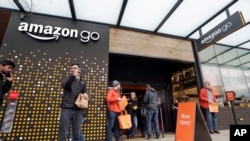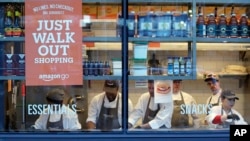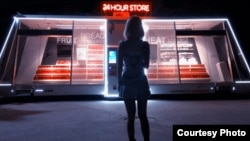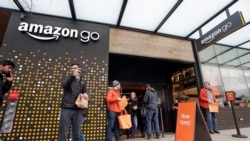The American company Amazon has launched a store that does not require you to stand in a checkout line or someone to process your payment.
You simply need an app on a mobile device, such as a smartphone. People with the app can enter the store, choose the products they want and then leave the store with them.
The company opened its first Amazon Go store this week in the state of Washington, after more than a year of testing.
You first need to download the Amazon Go app -- a computer program that helps you gain entry to the store. Once inside, hundreds of cameras and electronic sensors follow people’s movements and record all the products chosen.
The products are then placed in the app’s virtual shopping cart. In other words, the app remembers everything chosen by the customer. If you decide against buying one or more products before leaving the store, the software automatically removes those items from its memory.
The system is powered by artificial intelligence or AI technology.
At the end of the visit, the customer just walks out of the store with all the desired products. Payment is made automatically through the app, which is linked to the buyer’s credit card.
The first Amazon Go is a small food market, selling mainly ready-to-eat products and drinks. It sits on the first floor of Amazon’s headquarters in Seattle.
“It’s such a weird experience,” shopper Lisa Doyle told the Associated Press after trying out the new store. “Because you feel like you’re stealing when you go out the door.”
Another visitor, Paul Fan, said he tested the technology by turning off his smartphone, taking some products and then putting them where they did not belong. He said the app was not fooled and still recognized all the correct items.
Peter Gray told the Associated Press he usually makes purchases online to avoid store crowds. Gray said he was pleased with the new shopping experience. “Just being able to walk out and not interact with anyone was amazing,” he said.
Even though there is no need for cashiers to take payments, Amazon Go does employ workers. Some prepare food, while others refill product supplies and assist customers.
Gianna Puerini is vice president of Amazon Go. She told Reuters it is the first time this kind of computer technology has been used in a store setting.
“If you look at these products, you can see they’re super similar,” she said of two nearly exact Starbucks coffee drinks sitting next to each other. One had light cream added, while the other was coffee with no cream or sugar. But the technology learned to tell them apart.
Amazon has yet to announce plans for additional Go stores. Last year, the online marketer bought U.S.-based Whole Foods Market, giving the company 470 stores. But Amazon said it has no immediate plans to add the same technology to the larger and more complex Whole Foods markets.
Other companies are also working to create artificial intelligence-powered stores.
One of them is Standard Cognition, a startup company in California. The company has developed technology that works like that of Amazon Go. It uses machine vision cameras to follow customers’ movements.
The goal is the same – to let shoppers walk into a store, choose desired goods, and leave without going through a checkout line. But Standard Cognition seeks to sell its artificial intelligence system to businesses for use in their own stores.
Aipoly is another California startup developing camera-powered computer vision technology. Aipoly’s website says its products can create “fully autonomous markets.” The system “combines the understanding of human activity in real-time with the movement and interaction of objects,” the site said.
In addition to providing customers a checkout-free experience, the technology can also follow the movement of all company products. Aipoly says the AI data can help businesses – both big and small – continuously follow their full inventory of products.
Another company has taken the self-service shopping idea one step further – by making the stores autonomous and movable. Wheelys, a Swedish company, sells movable coffee stands worldwide. It also invented Moby Mart, a small market on wheels.
The AI-powered Moby Mart is about the size of a small bus. It offers products found in 24-hour markets, such as milk, fruits and medicine. People gain entry to the store through an app. It also uses cameras to observe the movements of people and products.
The developers say they created Moby Mart to be a self-driving vehicle that can be called to certain areas through an app. The vehicle has its own solar panels to power the electrical engine. The service has already been tested in China. And the company says on its website it plans to launch Moby II sometime in 2018.
I’m Bryan Lynn.
Bryan Lynn wrote this story for VOA Learning English. His story was based on reports from Amazon, the Associated Press, Reuters and other sources. George Grow was the editor.
We want to hear from you. Write to us in the Comments section, and visit our Facebook page.
________________________________________________________________
QUIZ
_______________________________________________________________
Words in This Story
checkout – n. a place in a store where people pay for goods or services
virtual shopping cart – n. computer software that lists all of the products to be bought
automatically – adj. largely done by a machine
artificial intelligence – n. the ability of computers to copy human behavior, such as making decisions or offering suggestions
credit card – n. a small plastic card that is used to make purchases
online – adj. connected to a computer or telecommunications system
weird – adj. very strange
amazing – adj. very surprising, great
autonomous – adj. taking part in an activity separately from other things
inventory – n. a supply of goods stored in one place














